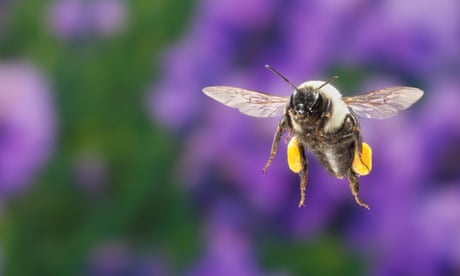
Bumblebees might be at home in town and country but now researchers have found at least one species that is even more adaptable: it can survive underwater.
Scientists have revealed queens of the common eastern bumblebee, a species widespread in eastern North America, can withstand submersion for up to a week when hibernating.
With bumblebee queens known to burrow into soil to hibernate, the researchers say the phenomenon could help them survive flooding in the wild.
The team said its next priority was to explore whether the results hold for other species of bumblebee.
“We know that about a third of all bumblebee species are in decline currently [but] it’s not the case with [the common eastern bumblebee],” said Dr Sabrina Rondeau of the University of Guelph in Canada, adding the team was keen to learn whether flood tolerance could play a role in their resilience.
Rondeau and her co-author, Prof Nigel Raine, first made their discovery when a mishap in the laboratory led to water getting into containers in which hibernating queen bees were kept.
“After that, of course, curiosity led the way to conducting a full experiment with a lot of repetitions,” said Rondeau.
Writing in the journal Biology Letters, the scientists describe how they took 143 unmated, hibernating queens of the common eastern bumblebee and placed each in its own plastic tube containing damp topsoil. The tubes were then fitted with perforated lids and kept in a dark refrigerated unit for a week.
After checking the bees were still alive, the researchers kept 17 tubes as controls and added cold water to the remaining 126. While the queen was allowed to float on top of the water in half of these tubes, it was pushed under the water by a plunger in the others.
For both conditions, a third of the tubes were each left for eight hours, a third for 24 hours and a third for seven days, simulating different flooding conditions. The team subsequently transferred the bees to new tubes and monitored their survival.
The results reveal survival rates were similar regardless of the duration and conditions the queens had been subjected to – indeed 88% of the controls, and 81% of the queens that were submerged for a week, were still alive at eight weeks. However, queens with a higher weight had a greater chance of survival.
The researchers say the findings are unusual given most insects overwintering as adults – including many ground beetles – cannot cope with being submerged in water and must leave floodplains to survive.
While Rondeau said it was likely queens of other bumblebee species were also flood tolerant, ground nesting bees – which include some species of bumblebee – could still be affected by flooding as their larvae may not survive.
Among future areas of research, the team said it would be interesting to explore the mechanisms that underpin the queens’ resilience to flooding – with their low oxygen requirements during hibernation among possible important factors.
Prof Dave Goulson, a bee expert from the University of Sussex who was not involved in the work, said bee enthusiasts had long speculated that increased winter rain amid the climate crisis could drown many queen bumblebees as they hibernate underground.
“Amazingly, this new research shows that hibernating queen bumblebees are entirely unaffected by being held under water for up to one week,” he said. “This seems to be one small aspect of climate change that we need not worry about.”